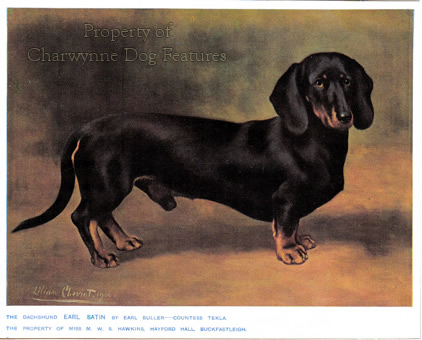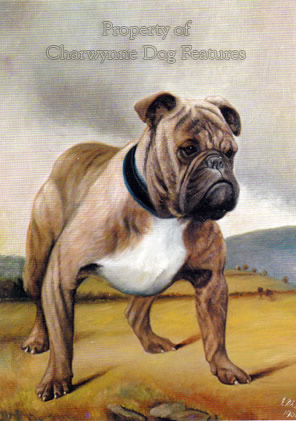869 NAMING OF PARTS
NAMING OF PARTS
by David Hancock
 There used to be a weapon-training lesson in the Army entitled 'the naming of parts' so that every user of live weapons was intimately familiar with the tools of his trade. After sitting next to a KC-approved judge at a Championship Show and a much-used lurcher judge at a country show and finding both unfamiliar with age-old nomenclature on a dog's anatomy, I think such a lesson might come in useful here! How can you learn more about your pastime if you don't know your gaskin from your keel or your squirrel-tail from your sickle-tail? Such descriptive words have a precise meaning and in past writings provided valuable advice to and from highly-knowledgeable dog-judges. The horse world is so much better at this naming of parts business. The colour of horses is described so much better than that of dogs; a griege Weimaraner, a bay Vizsla and a sorrel Rhodesian Ridgeback sound better than variations of brown, red or fawn.
There used to be a weapon-training lesson in the Army entitled 'the naming of parts' so that every user of live weapons was intimately familiar with the tools of his trade. After sitting next to a KC-approved judge at a Championship Show and a much-used lurcher judge at a country show and finding both unfamiliar with age-old nomenclature on a dog's anatomy, I think such a lesson might come in useful here! How can you learn more about your pastime if you don't know your gaskin from your keel or your squirrel-tail from your sickle-tail? Such descriptive words have a precise meaning and in past writings provided valuable advice to and from highly-knowledgeable dog-judges. The horse world is so much better at this naming of parts business. The colour of horses is described so much better than that of dogs; a griege Weimaraner, a bay Vizsla and a sorrel Rhodesian Ridgeback sound better than variations of brown, red or fawn.
Down-at-pastern is usually identified but cow-hocks and sickle-hocks less so; both are serious faults and need to be correctly interpreted by both judge and exhibitor - or the latter never learn. Nowadays a boney hound could mean an underweight one; it used to mean well-boned. Some breeds have their own vocabulary: the brisket or sternum in a Dachshund is the keel; the chest front of a Bulldog is its 'spread'. But when is a mantle different from a blanket when, say, the black on a black and tan dog is described? It matters when both words are used for the same feature and a newcomer gets confused. Breeds like the Greyhound, Whippet, Weimaraner, Vizsla and many lurchers display a defined tuck-up or inward curve from the last rib to the forward edge of the thigh. Such a concave physical feature is part of the dog's phenotype and its condition, but in the KC show rings the latter seems to matter less and less each year. A fat sighthound or unfit gundog is not a pretty sight!
A number of Breed Standards stipulate a 'hound-tail', but does that mean to an outsider the tail of a sighthound or a scenthound, each is carried very differently. A hound-tail usually means one carried high, but old hound breeders made a difference between that and a sabre-tail, based on the degree of upwards curve. The expression 'hound-marked' is similarly imprecise. The fallaway or slope of the croup is seldom used today but it does convey an immediate meaning. We hear talk of a showy or flashy exhibit, but the old expression 'flat-catcher' is more memorable. A pale red or yellow-brown dog used to be called a fallow one, but it has gone out of fashion. Chesapeakes can be sedge colour; how many town-dwellers have seen sedge these days? But colour matters less than terms concerning breeding. There is a huge difference between in-breeding, interbreeding and cross-breeding.
Skilled in-breeding has become known as line-breeding, ill-informed in-breeding is the problem with the majority of pedigree dogs. Interbreeding is the mating of dogs from different varieties of the same breed, so it matters whether the KC considers say the Belgian Shepherd Dog as one breed of four varieties or four different breeds. Narrowing the gene pool is rarely good sense. The KC considers a crossbred dog as one whose dam and sire are representatives of two different breeds; they don't define a mongrel! Close-breeding has been described by one wag as 'lucky in-breeding' but is conducted by far too many lacking the knowledge of line s, kennels and breeders to benefit from such information. Because so much pure-breeding is done for commercial gain and the general public seems to trust show breeders, it makes good sense to consult someone with knowledge than waste many hundreds of pounds on a sickly pet. The general public don't see the often damning critiques from experienced show judges published after each KC-approved dog show; they would need to know the glossary of canine terms to do so.
s, kennels and breeders to benefit from such information. Because so much pure-breeding is done for commercial gain and the general public seems to trust show breeders, it makes good sense to consult someone with knowledge than waste many hundreds of pounds on a sickly pet. The general public don't see the often damning critiques from experienced show judges published after each KC-approved dog show; they would need to know the glossary of canine terms to do so.
A good lurcher judge may not know show ring expressions for the movement of a dog, such as crabbing, plaiting, weaving, hock-snatching, rolling, pounding, paddling, over-reaching, knitting and pacing. But having watched dogs performing in the field for countless years is so much more likely to have 'an eye for a dog'. A judge at Peterborough is chosen because he knows the hounds' function - what they were designed for and what they are expected to do. This as those who work gundogs, and show them, realise to their cost sometimes. There are times when at a championship dog show, and even at a World Dog Show, and I've been to seven of those, when you despair at the judges' findings and placings. Some of them too don't know a gaskin from a ham - forgiveable in the general public, simply unforgiveable when you assess breeding stock, knowledge is power!